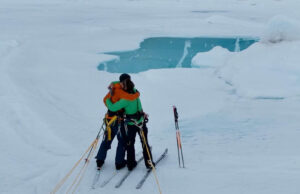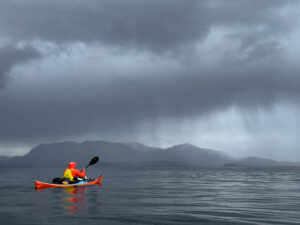The four kayakers who are attempting to do the entire 3,000km Northwest Passage recently took a week off in the town of Cambridge Bay to rest and resupply. That included getting new, non-leaky drysuits for their final section.
They are currently skirting the south end of Victoria Island and will then make a short hop to the Canadian mainland. From here, they will follow the coast west to their endpoint at Tuktoyaktuk.
West Hansen, Jeff Wueste, Mark Agnew, and Eileen Visser are paddling in two double kayaks. While they’ve had delays — most notably, 10 days at the beginning, waiting for open water off Bylot Island — they’ve put in consistently big daily distances when the winds have allowed it. Recently, they’ve covered 65km, 67km, 38km, 57km, and 48km.
Although early winter has arrived in the Arctic — earlier this week, they reported snow flurries instead of drizzle — they only less than 1,000km to Tuktoyaktuk. If the fall winds are not too bad, they may be able to finish before the end of the month, when winter really begins to set in.

The kayakers’ route and current position.
Engine use nullifies rowers’ self-propelled status
Meanwhile, a group who are rowing the same route as the kayakers (but continuing a little further to Alaska) are now approaching Cambridge Bay. Although they began their expedition much later, rowing is faster than kayaking, and they may overtake the kayakers before Tuktoyaktuk.
However, just before Bellot Strait the rowers used their boat’s electric motor to dislodge themselves from a sand bank on which they unexpectedly ran aground. (Soundings are few and not always reliable in the Arctic.) Minor though this engine use was, it does put an asterisk beside their self-propelled transit — just as an 8,000m climber who takes a few puffs on an oxygen bottle can no longer claim a no-O2 ascent.

The rowers’ current position.
A third party, solo rower Matty Clarke, continues efficiently in the opposite direction, from Tuktoyaktuk to Pond Inlet. He is currently east of Cambridge Bay and approaching King William Island. Clarke currently has farther to go than the other two groups but has been doing well alone since his partner became injured and had to quit.

Matty Clarke’s position, between Victoria and King William Islands.
The Northwest Passage has bedeviled arctic explorers for centuries because of short summers and unpredictable sea ice. Most famously, Sir John Franklin and his crew of 128 became bogged down in the ice off Northwestern King William Island in 1846. They abandoned their ships around 1848. Some managed to survive for two or three years after that, but ultimately, all died of starvation and disease.
Sea ice in the modern Northwest Passage can still block ships. In 2018, no ship made it through. Other summers, the ice clears out thoroughly, and 2023 has been one of those years.
The four kayakers (or Matty Clarke, if he puts on a spurt and finishes sooner) could claim the first self-propelled summer traverse of the Passage within a single year. In the spring of 2011, Eric and Sarah McNair-Landry kite-skied from Tuktoyaktuk to Pond Inlet over the sea ice.






